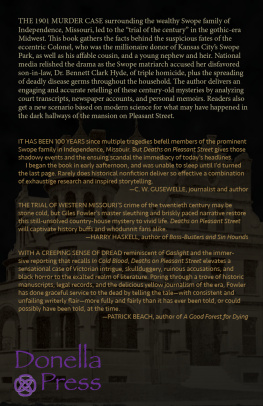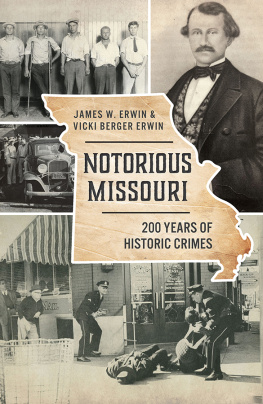Deaths on Pleasant Street
Copyright 2009, 2021, estate of Giles Fowler.
Originally published, 2009, by Truman State University Press, Kirksville, Missouri USA
Reprint edition by Donella Press, 2021.
All rights reserved. No part of this work may be reproduced or transmitted in any format by any means without written permission from the publisher.
Cover art: Swope Residence, Independence, Mo., ca. 1892. Courtesy of Missouri Valley Special Collections, Kansas City Public Library, Kansas City, Missouri. Used by permission.
Cover design: Teresa Wheeler
Type: MinionPro Adobe Systems Inc.; Raphael Adobe Systems Inc.
Library of Congress Cataloging-in-Publication Data
(for 2009 edition)
Fowler, Giles, 1934
Deaths on Pleasant Street : the ghastly enigma of Colonel Swope and Doctor Hyde / Giles Fowler.
p. cm.
ISBN 978-1-931112-91-8 (pbk. : alk. paper)
1. MurderMissouriCase studies. 2. Swope family. I. Title.
HV6533.M8F69 2009
364.1523092dc22
2009010471
Contents and Illustrations
Preface
Chapter One
The Swope home, 406 South Pleasant Street
Portrait of Mrs. Logan O. (Margaret) Swope
Portrait of Colonel Thomas Swope
Chapter Two
Portrait of Doctor Bennett Clark Hyde
Portrait of Frances Swope Hyde
The Hyde home, 3516 Forest Avenue
Swope mansion dining room
Chapter Three
Chapter Four
Portrait of Tom Swope
Chapter Five
Swope mansion left parlor
Facsimile of Colonel Swopes handwritten epitaph
Chapter Six
Portrait of Margaret Swope
Chapter Seven
William Chrisman Swope
Chapter Eight
Chapter Nine
Chapter Ten
Portrait of Lucy Lee Swope
Chapter Eleven
Doctor George T. Twyman in court
Swope mansion right parlor
Chapter Twelve
Doctor Edward L. Stewart in court
Chapter Thirteen
Chapter Fourteen
Col. Thomas H. Swope
A Home of Fatalities
John Paxton at the coroners inquest
Doctor B. Clark Hyde and Frances Hyde
Chapter Fifteen
Chasing Hatred Chase Jordan
Portrait of Frank P. Walsh
Portrait of James A. Reed
Chapter Sixteen
Nurse Pearl Kellar on the witness stand
Chapter Seventeen
Doctor Ludvig Hektoen, pathologist, and Doctor Walter S.
Haines, chemist, outside the courtroom
Doctor Victor C. Vaughan arriving at court
Mrs. Logan O. Swope on the witness stand
Chapter Eighteen
The Criminal Court Building and County Jail
The Criminal Courtroom
Plan of courtroom
The Rev. George W. Hyde and Mrs. Hyde in court
The jury
Chapter Nineteen
Nurse Anna Houlehan on the witness stand
Margaret Swope on the witness stand
Doctor Ludvig Hektoen on the witness stand
Doctor Walter C. Haines on the witness stand
Chapter Twenty
Doctor Hyde on the witness stand
A facsimile of the verdict
Chapter Twenty-one
Chapter Twenty-two
Sources
About the Author
Without doubt, the public generally refuses to believe, in the absence of positive proof, that a murder has been committed. It is too awful to be credible. If murder there was, it rivals the most grewsome [ sic ] tales of French fiction in its diabolical conception and boldness of execution. Every feature of the veiled hypothesis is a ghastly enigma of human depravity.
The Kansas City Journal, Jan. 21, 1910
What a Gaborieau or a Conan Doyle might have done with such material may be left to the imagination. Here was a plot, the elaboration of which, in fictional form, might have produced the worlds greatest detective story, though it would have taken a Poe to do full justice to a mind that could conceive the use of germ cultures to commit murder.
The New York World, May 16, 1910
Donella Press
Kirksville, MO
To my children, and in memory of Helen and Jonathan.
Preface
There is probably a useful history to be done on the legal controversies of the century-old Hyde-Swope murder case, especially the question of whether justice was served in the long, grueling prosecution of the accused doctor. Such a project would require the labors of a historian or a law scholar, neither of which I am. Certainly my book is no such ambitious work. Its aim is simply to recount the story, as fully and accurately as I can, of one of the darkest, most baffling mysteries of the last century in the place where I grew up. Until now, the tale has never been the subject of a full-length book, although it has produced innumerable articles and other writings since 1909, the year it all began. Like every account before it, this one will raise more questions than it answers, and perhaps for that reason it will dissatisfy. But the object, really, wasnt to solve the mystery but to reproduce it, concretely, in scenes that would have the textures and immediacy of real experience.
I wish I could say every word of the book is true. But it is only true insofar as the source materials and my interpretations are true. And as every reporter knows, there are many truths, too many of them pocked with errors, memory failures, lies, contradictions, and self-serving hype. However, I can say that nothing on these pages was made up out of whole cloth. When it was necessary to fall back on conjecture, I tried to make sure the assumptions were justified logically by the documented facts. Where the facts were unknown or blurred by conflicting versions, I tried to make that clear.
What amazed me at first, and then delighted me, was how rich in humanizing details the old records were. Again and again I came upon patches of action, interaction, high emotion, and dialogue that gave voice and personality to these beings from another time. Suddenly they were sentient, fallible, free-willed people. One such moment of discoveryout of hundredscame while reading the statement of a young doctor, who feared he might inadvertently have aided in a horrible crime. Home from his office, he takes his small son sledding, undresses the child for bed, struggles to focus on his evening paper, and at last rouses his sleepy wife to share with her his anxieties.
From the first, I planned to use reconstructed scenes as the main building blocks of the narrative. Here again, the individual statements and court testimony were amazing treasuries of detailed information. Equally so were the memoirs and other non-official accounts by the players, not to mention the lavish files of contemporary newspapers. But the reliability of all these sources, even the sternest court documents, obviously varied in degree. Trial transcripts tell us what a witness said, not whether a word of it was true.
Newspaper accounts were approached with caution, with allowances for the general quality of the papers coverage. Overall, the Star s reporting was more complete, sober, and responsible than that of the flamboyant Post . At the same time, certain Post writers showed impressive gifts for colorful observation and narrative where a Star or Times reporter might offer only workaday accounts.
With all the pitfalls regarding accuracy, it fell to this writer to cross-check and double-check as much as possible, down to the floor plan of the mansion (never fully established), the placement of a telephone on the wall, and the final score of a college football game. One depiction of a shocking medical crisis in the Swope home had to be assembled from the memories of seven individuals drawn to the scene from various parts of the house. Fortunately they were able to validate each others accounts.















